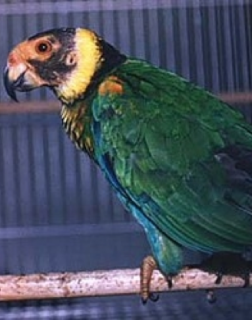Vulturine Parrot |
|
|
Photos
View in GalleryDid You Know?
Vulturine and Orange-headed Parrots are both bald-headed. This may be an adaptation due to the large, pulpy fruits it eats.Academic Research
Related publications: Pyrilia vulturinaSpecies Profile
Genus: Pyrilia | Species: vulturina
Size:
23cm (9 in)
Weight:
120g (4.2 oz)
Subspecies including nominate:
one
Colour Adult:
Both adults in general green; brown/yellow, bare forehead; yellow/brown lores and chin; black, bare crown to ear coverts and cheeks; occipital band reaching to throat yellow, bordered by black nuchal collar; dull olive/yellow upper breast with light black scalloping; red/orange bend of wing; red/orange lesser wing coverts; red carpal edge, axillaries and underwing coverts. Bill green/grey with yellow spot at base of upper mandible. Eye orange.
Colour Juvenile:
Brown/yellow, bare lores to area around eye, the remainder of head dull green and feathered; occipital band and nuchal collar absent; dull yellow/green upper breast; orange/yellow bend of wing and lesser wing coverts. Bill yellow in young birds.
Call:
Calls in flight are distinctive and flowing, a two-syllable series of notes.
Listen NowMore Information:
Content Sources:
CITES
BirdLife International
Cornell Lab of Ornithology/Birds of the World
Parrots: A Guide to Parrots of the World, Juniper and Parr, 1998
ML Media Collection Catalogue 114984, Vulturine Parrot Pyrilia vulturina, Marantz, Curtis, Para, Brazil, Aug. 31 1999, Cornell Lab of Ornithology. Site
Parrots of the World, Forshaw, 2006. 2010 edition
Parrots in Aviculture, Low, 1992.
Lexicon of Parrots, Thomas Arndt.
Photos
View in GalleryDid You Know?
Vulturine and Orange-headed Parrots are both bald-headed. This may be an adaptation due to the large, pulpy fruits it eats.Academic Research
Related publications: Pyrilia vulturinaSpecies Care
Captive Status:
Not found in aviculture; probably never kept outside of Brazil.
Longevity:
Not recorded.
Housing:
Large, sheltered aviary, indoors if in cold climate; minimum temperature 20C (68F).
Diet:
Tropical fruits such as guava, mango, papaya; various other fruits; seed mix such as: safflower, millets, oats, hemp and some sunflower seed; green leaves such as: Swiss chard, lettuce, sowthistle, kale, dandelion, chickweed; vegetables such as: carrot, celery, green beans and peas in the pod; minced baby food; vitamins and supplements; complete kibble if taken.
Enrichment:
Not recorded.
Nest Box Size:
Not recorded.
Clutch Size:
Not recorded.
Incubation Time:
Not recorded.
Fledging Age:
Not recorded.
Hatch Weight:
Not recorded.
Peak Weight:
Not recorded.
Weaning Weight:
Not recorded.
Photos
View in GalleryDid You Know?
Vulturine and Orange-headed Parrots are both bald-headed. This may be an adaptation due to the large, pulpy fruits it eats.Academic Research
Related publications: Pyrilia vulturinaSpecies Wild Status
World Population:
Unknown, decreasing.
IUCN Red List Status:
Least Concern
CITES Listing:
Appendix II
Threat Summary:
Uncommon within its relatively small range, which is rapidly being cleared of forest, particularly in the east. There is no known pressure from trade. The population density varies; it may be common in untouched habitat while uncommon in degraded and deforested areas.
Range:
E Amazonia in NE Brazil from E Amazonas to Para-Maranhao border.
Habitat:
Found up to 400m (1312 ft) in lowland tropical rainforest in both varzea and terra firme forest.
Wild Diet:
Feeds on fruits, seeds and berries.
Ecology and Behaviour:
Social. Seen usually in pairs during breeding season; outside season in groups of up to 10 birds. Quiet and easily overlooked in canopy foliage.
Clutch and Egg Size:
Not recorded.
Breeding Season:
Not recorded.
Photos
View in GalleryDid You Know?
Vulturine and Orange-headed Parrots are both bald-headed. This may be an adaptation due to the large, pulpy fruits it eats.Academic Research
Related publications: Pyrilia vulturinaMembers Only Resources
Please log-in now to find more research, resources and tools.
Not a Member?
Find more great information:
Gain exclusive access to 600+ pages of additional research, seminars and podcasts, specialists to ask your toughest questions, and dozens of other fun resources - when you become a WPT member.
Join Today >>

































